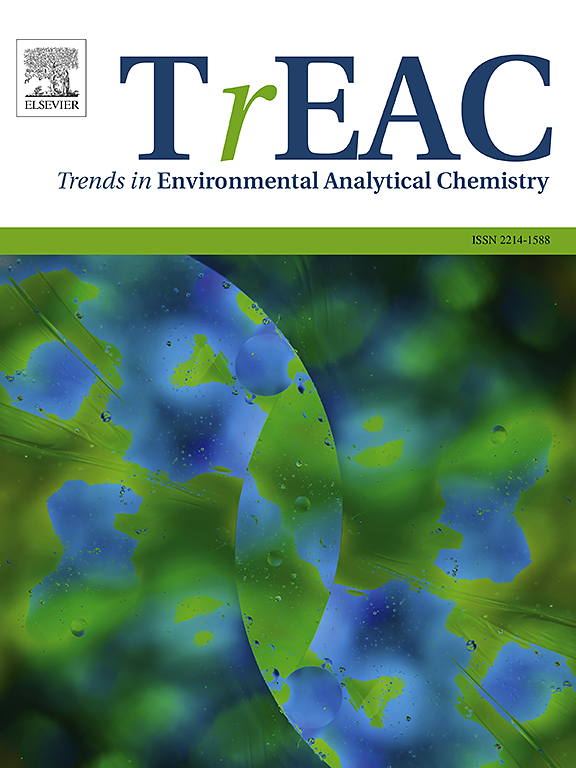Recent trends in use of plant-derived carbon dot-based fluorescent probes for heavy metal ion detection and their biological applications
IF 11.1
2区 化学
Q1 CHEMISTRY, ANALYTICAL
引用次数: 0
Abstract
Plant-derived carbon dots (CDs) have drawn a lot of interest as superior nanomaterials because of their sustainable nature, biocompatibility, and environmentally friendly synthesis, which sets them apart from other CDs made from non-renewable resources. The synthesis of CDs from natural sources such as fruits, leaves, bark, stem, flower, seed and biowaste by hydrothermal, pyrolysis, and microwave-assisted method have been investigated to modify the size and features of CDs. The plant-derived CDs exhibit greater sensitivity and selectivity, and their high photoluminescent properties makes it possible to detect physiological and ecological significant metal ions like iron (Fe³⁺), copper (Cu²⁺), lead (Pb²⁺), and mercury (Hg²⁺). This study focuses mainly on crucial elements such as absorption, emission, sensitivity, selectivity, and limits of detection of metal ions, a thorough examination of their sensing characteristics is provided. This review article comprehensively summarizes plant-based CDs with different synthesis methods, characterization techniques, metal ion sensing and its mechanism, stability and biological imaging of CDs. Additionally, we discussed the plant derived CDs for the detection of pesticides and drugs. These CDs also find extensive applications in environmental remediation by offering a sustainable alternative for detecting harmful pollutants. Beyond these sensing, their biological uses of plant-derived CDs, such as bioimaging, antioxidant activity, and therapeutic potential, are finally addressed. This review emphasizes the bright future of plant-derived CDs in biomedicine and sustainable nanotechnology, with a focus on their biological applications and improved sensing capabilities in research development.
植物源碳点荧光探针重金属离子检测的最新趋势及其生物学应用
植物来源的碳点(CDs)由于其可持续性、生物相容性和环境友好的合成特性而引起了人们的广泛关注,这使它们有别于其他由不可再生资源制成的CDs。研究了以水果、树叶、树皮、茎、花、种子和生物废弃物为原料,通过水热法、热解法和微波辅助法合成CDs,以改变CDs的大小和特征。植物衍生的CDs具有更高的灵敏度和选择性,其高光致发光特性使得检测铁(Fe³+)、铜(Cu²+)、铅(Pb²+)和汞(Hg²+)等生理和生态上重要的金属离子成为可能。本研究主要关注金属离子的吸收、发射、灵敏度、选择性和检测限等关键因素,并对其传感特性进行了全面的研究。本文综述了植物基CDs的不同合成方法、表征技术、金属离子传感及其机理、稳定性和生物成像等方面的研究进展。此外,我们还讨论了用于农药和药物检测的植物源cd。这些cd还通过提供一种可持续的检测有害污染物的替代方法,在环境修复中得到广泛应用。除了这些传感之外,它们在植物源性cd的生物学用途,如生物成像、抗氧化活性和治疗潜力,最终得到了解决。本文综述了植物源性cd在生物医学和可持续纳米技术方面的应用前景,重点介绍了植物源性cd在生物医学和可持续纳米技术方面的应用前景。
本文章由计算机程序翻译,如有差异,请以英文原文为准。
求助全文
约1分钟内获得全文
求助全文
来源期刊

Trends in Environmental Analytical Chemistry
Chemistry-Analytical Chemistry
CiteScore
21.20
自引率
2.70%
发文量
34
审稿时长
44 days
期刊介绍:
Trends in Environmental Analytical Chemistry is an authoritative journal that focuses on the dynamic field of environmental analytical chemistry. It aims to deliver concise yet insightful overviews of the latest advancements in this field. By acquiring high-quality chemical data and effectively interpreting it, we can deepen our understanding of the environment. TrEAC is committed to keeping up with the fast-paced nature of environmental analytical chemistry by providing timely coverage of innovative analytical methods used in studying environmentally relevant substances and addressing related issues.
 求助内容:
求助内容: 应助结果提醒方式:
应助结果提醒方式:


